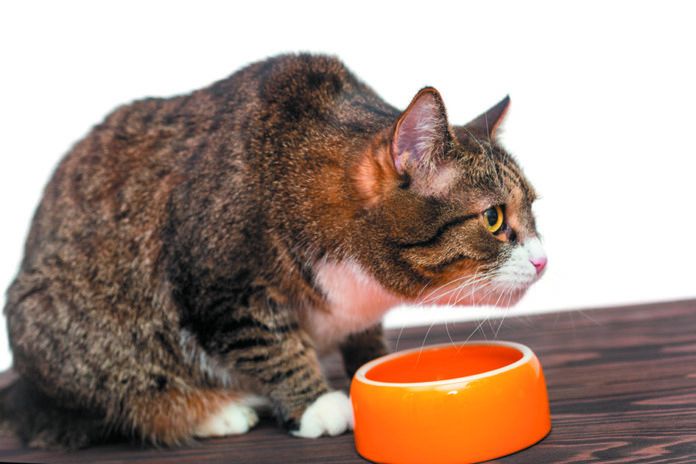“She has a sensitive stomach” is a common refrain heard by veterinarians. People want to know why their otherwise healthy cat vomits or has diarrhea or flatulence on a not-infrequent basis. The symptoms are not life-threatening or even terribly severe. The cat soon returns to herself. But owners are rightfully concerned.
And food manufacturers are onto them. Worry over GI upset has become big business — so much so that if you google “cat food for sensitive stomachs,” lots of ads will pop up to entice you to try a particular brand.
But before you switch foods, there are a number of other steps to take. The first is to talk to your cat’s veterinarian. There are a lot of reasons a cat may be vomiting here and there or having other GI problems, and they don’t all have to do with the food she eats. Even if your pet’s symptoms are mild and she generally seems fine, you want to rule out various conditions that could cause stomach upset — and treat them, if necessary — before deciding on your own that the problem is in the diet.
If the vet gives your cat a clean bill of health, you can check to see what in your cat’s food might be causing problems. Don’t automatically assume you’re looking to identify a food allergy. Food allergies are uncommon in cats. Intolerances to specific ingredients are not terribly common, either. More often, some property of the food — the amount of fat it contains, or the amount or types of fiber or any other component— simply “disagrees” with a cat. Or perhaps it’s something about the food’s overall digestibility.
You might never be able to figure out the exact reason for the “disconnect” between a food and your cat’s gastrointestinal tract, but the good news is that if you can identify which component of your pet’s diet is bringing on the unpleasant symptoms, you can easily switch it out for something else. There are always other choices. Here’s how to go about it, says board-certified veterinary nutritionist Cailin Heinze, VMD.
- Keep a journal of your pet’s symptoms for a couple of weeks to get a baseline read. Also write down every single thing that you feed your cat, including, say, your leftover cereal bowl that she licks clean of any residual milk.
- Once you have your baseline, stop feeding your pet anything other than her actual diet that you put in her bowl. No more cat treats, no more treats from your own plate, no more supplements that you have chosen to give your pet but that haven’t been deemed medically necessary, and so on.
- Don’t change anything about your pet’s diet, not even the flavor, let alone the brand. Things have to remain completely consistent.
- When you eliminate all the extras and are just feeding the base food, keep journaling every single day. You want to be able to document any changes — or lack of changes — in her reactions. Stick with the new protocol for twice the length of time that typically passes from one gastrointestinal episode to another. For instance, if your pet throws up, on average, once a week, feed only her diet and nothing else for at least two weeks. That’s the only way you can determine if having removed all the other foods is making a difference.
- If your cat starts doing better, add back the old treats one at a time — perhaps one every few days. That will help you determine which particular food may have been causing the GI upset. Keep writing in the journal. You will be amazed at the degree to which keeping track will help you identify the offending food — or potentially a non-food factor. (For instance, maybe your cat vomits only after your nieces and nephews visit.)
If your cat doesn’t start doing better (and the symptoms remain as mild as they had been), talk with your veterinarian about switching her main diet. Don’t automatically assume that a diet marketed as appropriate for “sensitive systems” is the way to go. There are no regulations surrounding marketing food for sensitive tummies. The ingredients and the nutrient concentrations can essentially be whatever the company decides.
Dr. Heinze recommends a diet made by a reputable manufacturer with a veterinary nutritionist on staff, or at least someone with a PhD in companion animal nutrition. She also advises choosing a food with a short ingredients list to cut down on the number of possibilities for stomach upset.
A vet can help you select a diet that’s lower in fat if your cat has been eating a high-fat diet or one that has a different amount of fiber — or a food with a higher overall digestibility. The solution may be in making one of those changes.
Introduce the new food gradually, taking a full week to completely switch from the old food to the new one. Sometimes even just simple food changes can result in an upset stomach for a cat, and you don’t want to compound the problem.
If your cat doesn’t improve or if her condition worsens, it’s time to talk with the veterinarian about checking for a food allergy and perhaps putting the cat on a therapeutic diet that can be purchased only with veterinary approval. Sometimes it may take more than one try to get the right diet. Sometimes a cat may not need an entirely new diet but could benefit from a fiber supplement.
A veterinarian will help you keep it calm and methodical. What you want to do is avoid a willy nilly approach of frequently changing your cat’s diet out of frustration and not having a plan or being aware of the changes you are making with regard to ingredients or nutrients, or not keeping a journal or log. That makes it all the more difficult to get to the bottom of the problem and find a lasting dietary solution.




